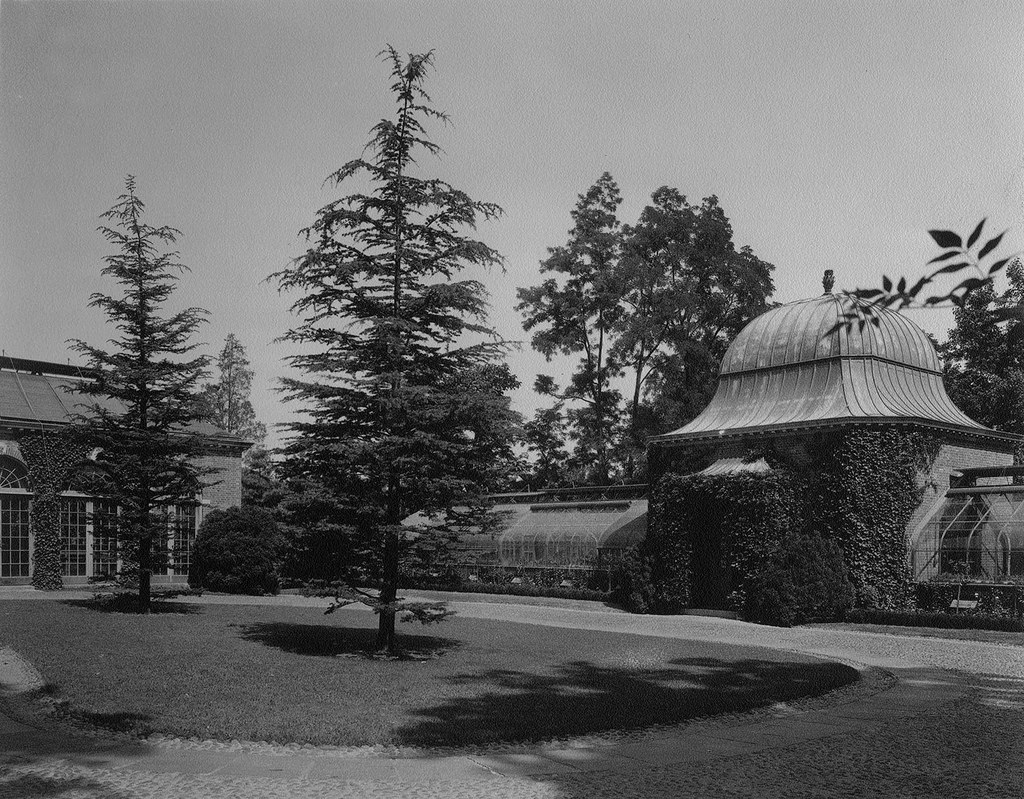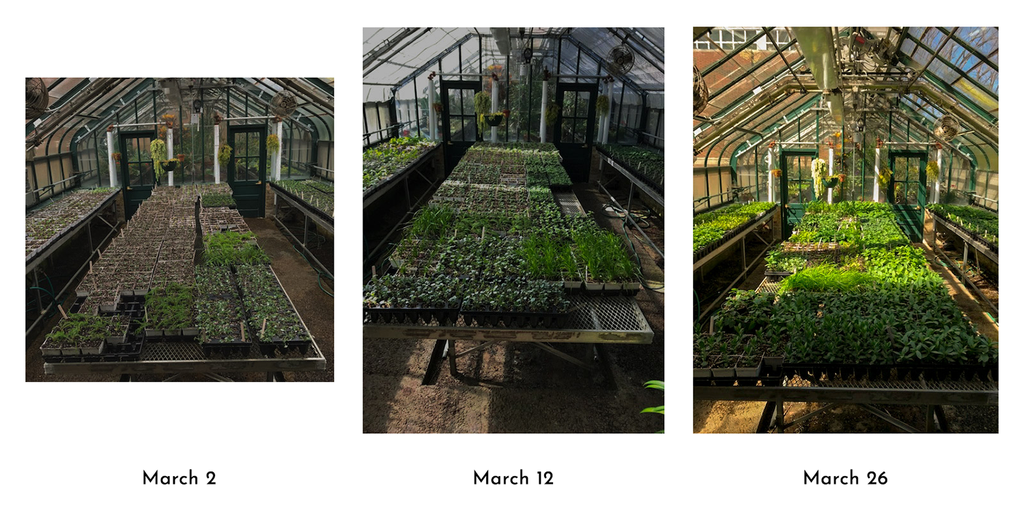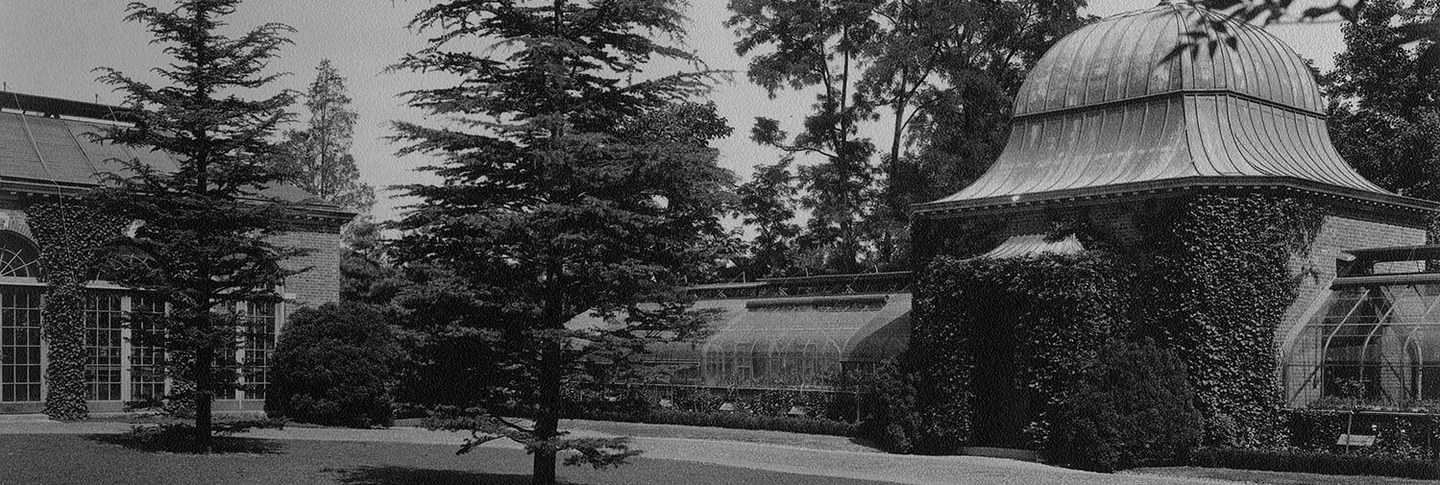By Melissa Brizer
The Dumbarton Oaks Greenhouse was built in 1925. Over the next few years the building grew, as wings with more space were added until 1932, when it assumed the form we know today. I’ve heard stories of Mildred Bliss, in her wheelchair, having tea in the headhouse with Franco De Simoni, a gardener she recruited from his home in Milan, Italy. I imagine her picking out the plants she wanted in the house, decorating the music room and the sitting room. I often wonder if she could possibly dream of me, 100 years later, growing plants for her garden.

When I first arrived at Dumbarton Oaks as a garden intern in 2003, the Greenhouse was a very different place. Under the direction of De Simoni and his assistant Sergey Gerasimov, it was overflowing with small houseplants and orchids. The window vents and shades were manually cranked with large wheel cranks. The windows were made of standard glass that shattered frequently in storms and from falling debris—I still find pieces of broken glass in the landscape around the Greenhouse. At that time De Simoni was responsible for a plant in every office in the Main House, along with large ferns and orchids in the Music Room. In 2005, in conjunction with the new library, the Greenhouse was remodeled. This project brought in a computer system called Microgrow that controls the shades and vents. The glass was replaced with a much safer tempered glass. De Simoni retired in 2005, and I was promoted in 2006 to run the Greenhouse.
Following extensive renovations in the Main House, plants were no longer allowed in the offices or Music Room for fear they would bring in bugs that might damage the collections. This allowed us to transition to using the Greenhouse strictly for production purposes: I supply all the vegetables for the vegetable garden, the annuals we use in the garden beds, and the chrysanthemums for the fall plantings. It’s very satisfying to see all these little babies, planted in the early spring, grow into large adult specimens in the garden. During the annual symposia, I often receive comments from shocked visitors on how different the Greenhouse looks compared to their previous visits. It went from an overgrown jungle to an efficient growing space focused on production throughout each of the four seasons.
Winter
I start in January with seed planting. The spring vegetable and herb seeds are first, including leeks, kale, onions, cabbages, parsley, and basil. Once the seeds arrive and are planted, things start happening quite quickly. Within just a few weeks, sprouts are growing and require fertilizer before being transplanted into bigger pots. In February, the chrysanthemum production begins. I take cuttings from our existing mum collection and grow them under mist until they take root. It takes a few weeks for them to get started, and during this time they need almost constant attention. They can’t get too wet or too dry, and they need to be monitored for pests and diseases. It’s a delicate balancing act with the mums, one I’ve perfected over the last fifteen years.
While I tend to the plants in the Greenhouse, I also make flower arrangements for our institutional events. In the winter, I go to the flower shop to buy the materials and then bring them back to the Greenhouse to arrange, but once the Cutting Garden starts blooming in the spring, I’m lucky enough to be able to gather everything from our own garden. The annual symposia require dozens of arrangements for the tables, buffets, and bars. I make floral arrangements for the director’s weekly events and for special events in the museum. The flower arrangements give me a chance to really get creative with shape and color, and I love it. With the COVID-19 closure, I’ve missed this part of my job over this past year with all our events being virtual.
By March, approximately 3,000 annual plugs arrive and need immediate attention. Because of their tiny size, they need to be transplanted into bigger pots immediately upon arrival. At this point, the chrysanthemums also need to be transplanted into bigger pots. It’s challenging to make this happen all at once in this deteriorating old building. The past three years have brought major water leaks in the garden; consequently, I lose water in the Greenhouse at the most crucial times. When this happens, you’ll see me dragging hoses over from the refectory in desperation to keep the tiny plants wet. Much to my amazement, the plants have always managed to survive.

Spring
Orchids start to come alive in the early spring, and by April they are blooming. I place the orchids in the lobby of the Main House, the Director’s House, and sometimes at the guard desk in the library. They decorate the registration tables for our symposia and the guard desk at the Fellowship House. They continue to bloom until the summer heat sets in in June. Most orchids go into dormancy at 85 degrees, and my Greenhouse has no cooling. The poor orchids limp through the summer and come alive again in the cooler fall.
Spring is a very busy time: the benches are full, and my plantings are almost ready to go outside. By April, the vegetables and some of the annuals are placed outside the Greenhouse under the plum trees to acclimate before the gardeners take them out and plant them. The summer vegetables like peppers and squash, along with annuals for the Cutting Garden, are planted from seed. By the middle of May, most of the plant material is outside, and half of it is already thriving in the garden beds.
Summer
Summer is the quietest season in the Greenhouse. This is my opportunity to give the building a deep clean and disinfect. The few tropical plants left inside are divided and repotted, the orchids are transplanted into bigger pots, and cuttings of begonias and salvias are taken in preparation for the next year.
Autumn
As the weather changes and temperatures start to drop, everything that is too tender for our DC winter returns to the Orangery and the Greenhouse. Because of garden visitors, the prettiest specimens end up in the Orangery, while the plants in need of some TLC come back to the Greenhouse for rehabilitation. Fall vegetable seeds are planted. The gardeners evaluate the chrysanthemums in the garden and choose the best-looking specimens for stock. The cold frames in front of the Greenhouse are cleaned out and restocked with mum and salvia stock plants for the next year’s cuttings.
As late fall sets in, my attention turns to holiday decorating. I order poinsettias and Christmas trees and place them in the museum and the residences. The large tree in the Music Room is always a big production. It arrives and sits in front of the Greenhouse for a few days while Marc Vedder, one of the gardeners, sprays it with a fixative so the tender needles don’t fall off. All the gardeners carry the tree up through the garden together to the Music Room terrace, where it’s brought into the building very carefully. It typically takes an entire day to light the tree, with a few of us on our big ladders to reach the top—it’s truly a showstopper every year. I make wreaths for the exterior doors and the Main Gate on R Street. When the campus is sufficiently decorated, I prepare the Greenhouse to be shut down over winter recess.
It all starts over again in January. Next year is especially busy; Greenhouse renovations are scheduled to start in spring 2022 and preparations are already beginning. This “old lady” is being completely gutted and rebuilt from the ground up. The historic facade will look exactly the same, but the production inside will be much more efficient. We’re having new computer systems installed to more precisely control heating and cooling (the orchids will be so happy!), and a brand-new space we’re calling the frameyard is being built on an existing foundation adjacent to the Vegetable Garden. This addition will give me the extra space I need for the chrysanthemums and vegetables, which will be most welcome.
As we celebrate the Garden Centennial in 2021, I’m reminded of the past century’s work in the Greenhouse with contributions from people like De Simoni and Gerasimov, under the supervision of Mildred Bliss. The Centennial is not just a moment for reflection but also an opportunity to look forward to the next hundred years in this old building and the continued guardianship and nurture of the gardens we know and love.
Melissa Brizer is the Greenhouse manager.

